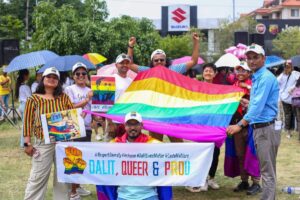On 10th June 2023, hundreds walked from Shantibatika to Narayan Chaur as the federal capital of Nepal, Kathmandu hosted the 5th edition of Queer Pride Parade. While the sky was sunny, the march boasted rainbows all around — from flags, posters, placards. However, people saw many new things during this parade that were never seen in the previous parades.
A group of Dalit Queer community were marching with the rainbow flag with Ambedkar’s face sketch, a portrait of Indian Dalit Queer activist and scholar Akhil Kang, with a slogan such as “Dalit, Queer and Proud”, “No liberation without Dalit Queer liberation”, “Caste is everywhere”, “Caste question is ignored in queer movement, until when?” After the group reached Narayan Chaur, the stage was set for poems, songs, dance performances and speeches.
“The queer movement has always overlooked the experiences of diverse communities. As you can see, the stage (for the performance) has no representation of Dalits. Don’t we have a talented LGBTQIA+ Dalit community here in Nepal? Obviously, we do.” -Sulochana N. Panchakoti, a Dalit queer activist.
Roshni Karna, Rojan Pariyar, and Sulochana N.Panchakoti initiated the first Dalit Queer parade in collaboration with Samari Utthan Sewa (SUS), a national NGO advocating Dalit rights in Nepal. Many Dalit civil society organizations and public intellectuals e.g. Dr. Suraj Yangde, one of India’s leading Dalit scholar and public intellectual, and Prof. Dr. Sanjeev Upreti, leader of Civil society movement, Nepal, also participated in the parade and expressed their solidarity to the first Dalit Queer pride parade. The event was widely covered by the national broadsheets The República, Kantipur Daily, The Kathmandu Post, and Asianews.
“While numerous organizations advocate for the rights of queer individuals, there are organizations established for the LBT individuals, transgenders, or working for the digital rights of queer people. However, there was an absence of an organization solely dedicated to the rights of Dalit LGBTQIA+ individuals. Thus, our participation in the pride parade with the powerful message of Dalit, Queer, and Proud was a realization that Dalit Queer Nepal stands with us when no one else does.” said Rojan Pariyar, a member of Dalit Queer community.

“The queer movement has always overlooked the experiences of diverse communities. As you can see, the stage (for the performance) has no representation of Dalits. Don’t we have a talented LGBTQIA+ Dalit community here in Nepal? Obviously, we do.” said Sulochana NP, a Dalit queer activist.
This is my first experience at the pride parade, and bringing up the caste issue in the queer movement was a highlight of Nepal’s pride celebration. However, I could sense curiosity and questions in the eyes of other participants, wondering if we were bringing caste in every aspect, shared Ram Pukar Mahara, a Dalit (Madhesi) rights activist.
According to the research conducted by Samari Utthan Sewa in 2022, among the 39 member organizations of Federation of Sexual and Gender Minorities in Nepal, majority of the leadership space is hold by so called high caste Hill Brahmin/Chhetri (31%), Madhesi non-Dalits (36%), Ethnic Communities (23%) and Newar (10%). There is zero representation of Dalits in the structure of the organization, who are working for advancing LGBTQIA+ rights in Nepal.
Another member of Dalit queer community, Rosni said, “It is always good to be with people who feel like you. I am glad to be part of this pride parade where our voice has been raised out loud. This has given me the strength and motivation to fight for the rights of Dalit queer across the country.”
According to the research conducted by Samari Utthan Sewa in 2022, among the 39 member organizations of Federation of Sexual and Gender Minorities in Nepal, majority of the leadership space is hold by so called high caste Hill Brahmin/Chhetri (31%), Madhesi non-Dalits (36%), Ethnic Communities (23%) and Newar (10%). There is zero representation of Dalits in the structure of the organization, who are working for advancing LGBTQIA+ rights in Nepal.
The history of the Dalit movement reveals the significant contributions made by Dalit women in their quest for justice and equality within the Dalit community. The first Dalit women lead organization is Pariganit Nari Sangh, which was founded in 1955 AD, in the leadership of Mithai Devi Biswokarma. The founding leadership of the organizations were the protesters of the historical Pashupatinath Temple entry movement of 1953.
The primary objective of Pariganit Nari Sangh was to focus on women’s education and combat the prevalent caste-based discrimination. Through this organization, Dalit women were organized, mobilized, trained, and gradually integrated into the ongoing Dalit struggle. Their involvement served as a significant step towards the collective effort of Dalit women for addressing the systemic marginalization faced by them.
Another notable organization that emerged within the Dalit movement was the Feminist Dalit Organization (FEDO), established in 1994 by a group of Dalit women. FEDO aimed to eliminate caste and gender-based discrimination, with a particular emphasis on the economic empowerment of women, women’s rights, leadership development, inclusive governance, and social justice. Central to FEDO’s initiatives was the prioritization of Dalit women, recognizing their unique challenges and advocating for their empowerment.
Furthermore, the Centre for Dalit Women (CDWN), established in March 2016, stands as another prominent Dalit women led organization. CDWN works tirelessly for the political inclusion of Dalit women in state structures.
Despite these notable advancements, it is crucial to acknowledge that the issue of the Dalit Queer community, who face immense marginalization, has often been overlooked within Dalit and Dalit women’s organizations. The struggle to include the marginalized voices of the Dalit Queer community within these organizations remained an area that requires further attention and concerted efforts.









Discussion about this post